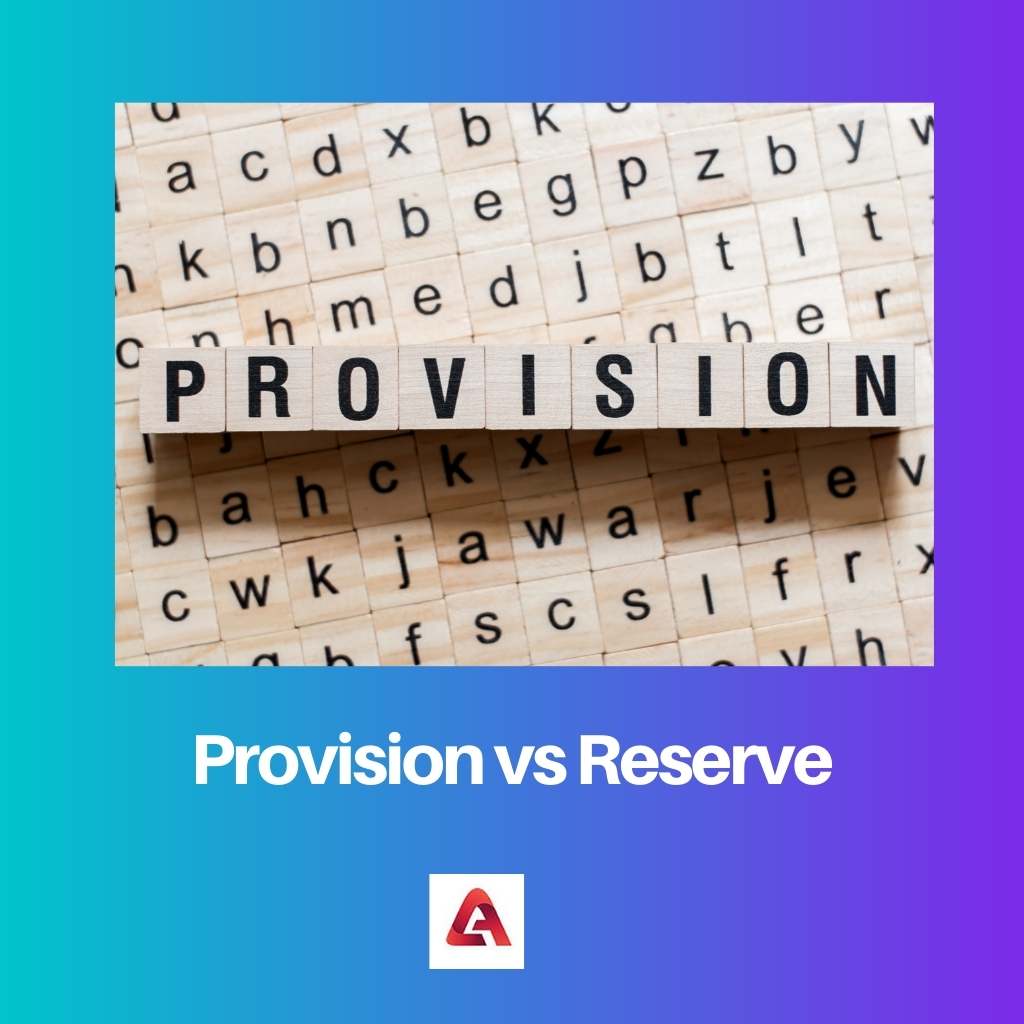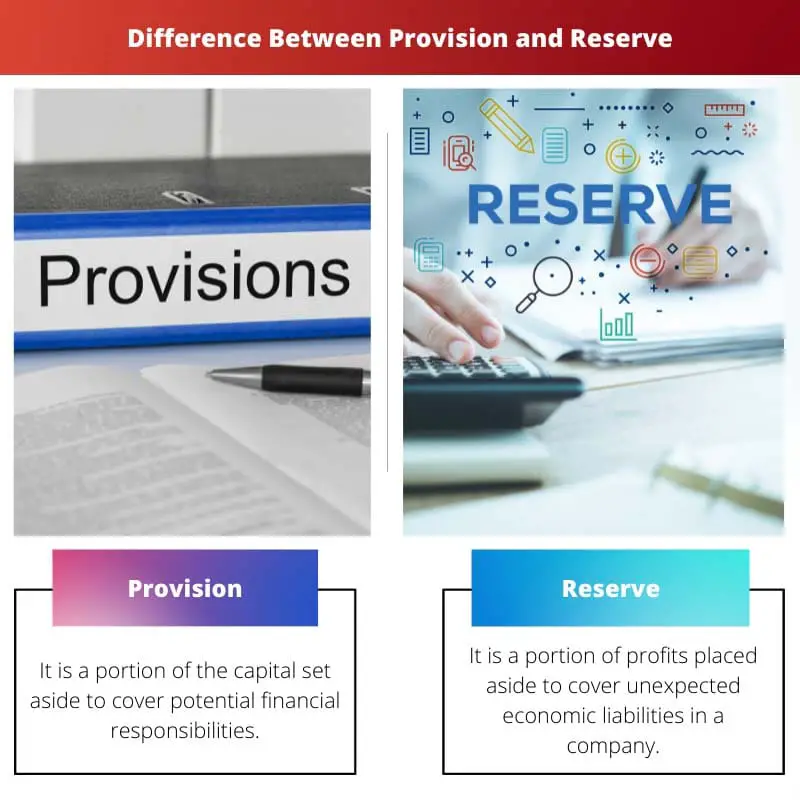Both provision and reserve are amounts of money that the company keeps away for saving. Since these two are so similar, some may confuse them with one another.
However, they are not the same thing. Thus, the terms should not be used interchangeably. There are some very distinct points of difference between the terms-provision and reserve.
Key Takeaways
- Provision is an amount set aside for a specific purpose, while the reserve is an amount set aside for contingencies or emergencies.
- Provision is a liability in accounting, while the reserve is an asset.
- Provision is made for expected expenses or losses, while the reserve is for unexpected events or uncertainties.
Provision vs Reserve
The provision refers to the act of setting aside an amount of money to cover potential future expenses. A reserve is an amount of money set aside for a specific purpose. Provisions are set aside to cover potential losses or liabilities, while reserves are set aside to support ongoing operations.

A provision is the sum of a cost or asset reduction that a company chooses to record in its financial accounting before having precise knowledge regarding the actual extent of the expenditure or asset reduction.
An organization, for instance, keeps track of provisions for bad debts, sales concessions, and obsolete inventory regularly. Termination payments, impairment charges, and reorganization costs are less usual provisions.
A reserve is a set of profits. It is set aside for a specified purpose. A capital reserve is the most frequent reserve, in which monies are cast aside to buy fixed assets.
The board members separate funds from the company’s general operational costs by leaving aside a reserve. There is seldom any judicial limitation on the use of monies that have been “reserved”; hence, the reserve is unnecessary.
Instead, management merely makes a note of anticipated cash requirements and finances accordingly.
Comparison Table
| Parameters of Comparison | Provision | Reserve |
|---|---|---|
| Meaning | It is a portion of the capital set aside to cover potential financial responsibilities. | It is a portion of profits placed aside to cover unexpected economic liabilities in a company. |
| Convenience | It is the sum deducted or charged from the profits of the company. | It is the Profit Portion. |
| Purpose | It shields a firm against unanticipated financial obligations. | It assists in the continuation of corporate activities while also protecting them from unexpected responsibilities. |
| Allocation | Financial gain is not necessary for allocation in this case. | Financial gain is necessary for assignment in this case. |
| Importance | The creation of provision is necessary by law. | The creation of reserves is not compulsory. |
What is Provision?
It is a sum placed aside from a company’s profits. This sum is to meet an anticipated responsibility or a loss in the price of an item, even if the actual amount is uncertain.
A provision is not a savings account. Rather, it is a declaration of an impending debt.
A provision is commonly referred to as a reserve in the International Financial Reporting Standards (IFRS); however, reserves and provisions are not interchangeable ideas.
A reserve is a portion of the profitability of a firm placed aside to strengthen the financial situation of the company through development or extension, while a provision is supposed to pay anticipated responsibilities.
A provision for bad loans is the most prevalent sort of provision. A provision for the bad debt has been prepared to meet the obligations. These obligations are not supposed to be paid within an accounting period.
This contingency is frequently included in the company’s budget and can be approximated based on previous debt history and market statistics.
The correspondence theory in accounting argues for recording spending and revenues in the same financial period. It is because expenses from one year that are paid for in prior or future financial years might be confusing.
By providing that charges are recorded in the same accounting cycle as the pertinent spending, provisions change the current year balance to be more precise.
A balance sheet records this sum of money. It is also deducted from the financial statements.
What is Reserve?
It is money that has been set aside for profit or benefit. These are for a specified purpose. The creation of reserves is to purchase fixed assets, pay bonuses, pay an anticipated legal settlement, pay for repairs and upkeep, and repay debts.
When a company makes a profit at the end of the year, a portion of it is kept in the trading business to meet future needs, growth projections, and more. Reserves are a term used in accounting to describe the sum of money saved.
The capital reserve is built up from capital profits that are not distributed as dividends to shareholders. It cannot be derived from profits generated by the basic operations of a company.
Income reserves are created from profits generated by the management of the firm. On the liabilities side of an accounting record, reserves are shown in the Reserves and Surplus portion.
Except for donated or primary share capital, a reserve might emerge in any element of the shareholder’s equity.
The unconstrained cash on hand sufficient to operate an organization is referred to as an “operation reserve” in nonprofit accounting, and nonprofit boards set a goal of keeping several months of working capital or a proportion of yearly income, known as an Operating Reserve Ratio.
Main Differences Between Provision and Reserve
- Provision is a portion of the capital set aside to cover potential financial responsibilities. The reserve is a portion of profits placed aside to meet unexpected economic liabilities in a company.
- Provision is the sum deducted or charged from the profits of the company. On the other hand, it is not the same with reserve. It is a portion of the profit.
- The provision protects a company from unexpected financial commitments. On the other hand, reserve assists in the continuation of corporate activities while also safeguarding them from unforeseen responsibilities.
- Financial gain is not necessary for allocation in case of provision, unlike in the reserve where there must be Financial gain for the assignment.
- The creation of a provision is necessary by law, but the creation of a reserve is not compulsory.

- https://ieeexplore.ieee.org/abstract/document/6965657/
- https://ieeexplore.ieee.org/abstract/document/761875/

This article certainly provides a comprehensive analysis of provisions and reserves. It’s a good read!
The article has failed to recognize the lack of insight into the implications of these differences. It should provide more practical examples to illustrate the points made.
I respectfully disagree. The examples provided are quite sufficient to understand the concepts.
The clarity of this article is absolutely astounding! The comparison table is particularly helpful.
The article does an excellent job at explaining the differences between provision and reserve. I completely understand the distinction now.
I agree. The explanations are very clear and concise.
It’s about time an article provided such a thorough comparison of these terms. It’s very informative.
This article is spot on! The information presented here is incredibly useful for professionals and students alike.